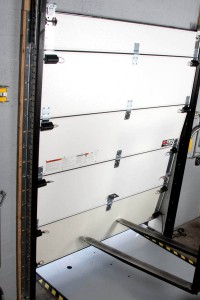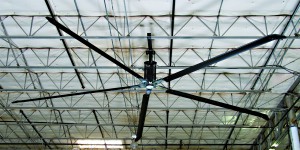Statistics point to the loading dock as being a danger zone, where it is estimated 25% of accidents leading to injuries occur. And the costs of these types of injuries can quickly add up. In fact, one Liberty Mutual Safety Index report revealed that these kinds of incidents cost the material handling industry $6.6 billion annually. That’s a lot of spending on what could be preventable occurrences.
So why don’t we just ‘prevent’ these accidents?
It’s not that simple, the problem is that there can be up to hundreds of doorways along the loading dock, each typically 8’ x 10’ holes in the wall. These doors can permit moisture to enter the area and mix with dirt, debris and oil creating a dangerously slick surface.
To truly prevent accidents you need to first avoid the conditions that lead to hazards.
- Start with your dock doors: Doors are often the first to suffer damage from the fast-moving forklifts in the confined
 dock spaces loading and unloading trailers. Collisions can damage doors outright, or they can at least compromise their ability to seal the doorway. The resulting misalignment creates gaps that enable the invasion of moisture into the facility. Some folks replace lower panels, where most damage occurs with “flex panels” to ensure the doorway is covered. Nevertheless management generally finds damage occurring at all points of the door and decides it is best to install a fully impactable door. Impactable doors are designed and built to stand up to both the occasional bump and the most severe impacts from forklifts, product loads and even trailers. Rather than becoming damaged from the force of a major impact, the door panels simply release from their track and can easily be set back in place. This type of door offers superior durability over standard doors, but can also prevent the transmission of heat from the outside, preventing chilled interior air from condensing and dripping on the floor.
dock spaces loading and unloading trailers. Collisions can damage doors outright, or they can at least compromise their ability to seal the doorway. The resulting misalignment creates gaps that enable the invasion of moisture into the facility. Some folks replace lower panels, where most damage occurs with “flex panels” to ensure the doorway is covered. Nevertheless management generally finds damage occurring at all points of the door and decides it is best to install a fully impactable door. Impactable doors are designed and built to stand up to both the occasional bump and the most severe impacts from forklifts, product loads and even trailers. Rather than becoming damaged from the force of a major impact, the door panels simply release from their track and can easily be set back in place. This type of door offers superior durability over standard doors, but can also prevent the transmission of heat from the outside, preventing chilled interior air from condensing and dripping on the floor. - Stop air from entering your facility: It’s true to say that standard pit-mounted dock levelers provide efficient trailer access for forklifts. However, the pit cut into the concrete dock floor allows small gaps that act as a passageway for moisture. Even a tightly closed and sealed door doesn’t always prevent moisture from infiltrating through the gaps. A solution to for both new and existing pit-style dock levelers is to outfit them with an advanced ENERGY GUARD™ perimeter weatherseal system—a combination of durable open-cell foam and heavy-duty vinyl. This system effectively fills the gaps around the sides and rear of the dock leveler and provides a superior perimeter seal.
- Door seals make all the difference: To proactively keep moisture away from your loading dock you ought to have equipped your loading dock with dock seals and shelters to close off the gap between the dock wall and the trailer, thus preventing the invasion of dirt and other debris. Dock seals have fabric-covered foam pads that compress when the trailer backs into them, providing a tight seal around the sides of the trailer and closing the gaps between the trailer’s door hinges. Dock shelters create a canopy around the perimeter of the trailer, allowing full, unimpeded access to the trailer interior.
- The Kelley HINGE GUARD™ Dock Shelter System is specially designed to close off trailer hinge gaps. What does that mean? Just imagine, a trailer pulls into a loading dock, the driver opens the trailer doors. Now step back and look in-between every hinge and you will see gaps allowing all types of weather to rush in, creating potential for a dangerously slick floor. HINGE GUARD is designed to effectively seal the perimeter and stop air movement between the exposed trailer hinge gaps along the sides of 102” (8’-6”) wide trailers with swing-out doors.
- Circulate energy smart air: The even coverage provided by a Kelley industrial HVLS fan works to reduce moisture in the air
which helps to keep your floors drier and safer for your employees. These fans move large volumes of air at low speeds over very great areas, dissipating moisture and creating drier dock floors. The fan blades produce a massive column of air that flows down to the floor and outward in all directions, creating a deep “horizontal floor jet” that ultimately circulates air up vertically and gets drawn back through the top of the fan.
The next time you are asked about your safety procedures at your facility, think about the equipment you are replying on to help you achieve your goals. Without the necessary equipment in place to avoid moisture on any loading dock, you are basically fighting a losing battle. Give yourself, your supply chain and your objectives a chance at success by choosing smart from day one and preventing the 25% of preventable accidents.

